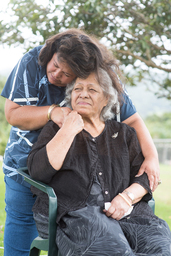 Ulu Garmon
Ulu Garmon “The ocean was my front door. You could smell it, you could hear it, you could feel it,” says Garmon. “There were a lot of trails between the streets and that's how we went to school. We had relatives on every road and so we would make trails to their houses,” she adds.
Born in 1934, Garmon’s insulated life was abruptly shattered with the onset of World War II. “The war started and they built an army base in front of my grandmother's house. And then they built a naval base in front of our house. That was Keaukaha for a few years with the military influx. Our ocean was barb-wired and we had to learn how to crawl through to go swimming” says Garmon.
Much like her mother and two sisters, Nalani and Pualani, Garmon became adept at maintaining cultural roots while traversing the Western world. “By the time the war was ended, we had to go outside of Keaukaha to go to intermediate and high school. A larger introduction to people other than Hawaiians,” says Garmon. Singing became her focus. “I had no time to do other things. I belonged to a quartet and then the district choir and the church chorus,” Garmon says.
After graduation, Garmon discovered how far she could stretch her roots when she was sent to Rexburg Junior College in Idaho. “I came home in December. I could not live away from the ocean. It was the worse kind of ache,” says Garmon.
 Daughter Leiola holding a family photo
Daughter Leiola holding a family photo Eventually the family was able to return to Hawaii Island and moved to Waimea in 1978. In 1982 Garmon became Waimea School’s Kupuna or cultural practitioner. “I felt it was necessary for them to learn about being Hawaiian, the birth of the islands and Pele. As a story teller, I wanted them to be their own story teller. Each table would come up with a story about what they had learned and they were wonderful,” says Garmon.
Next Garmon worked with OHA from 1985-1990. “Aunty Betty Jenkins on Oahu came here for a workshop and she asked if I would be interested in coming to Oahu and working on a curriculum. I went as a member of a cultural team,” says Garmon.
 Edith Kanaka'ole
Edith Kanaka'ole Garmon then began her work with veterans suffering from PTSD, taking the first groups to Waipio Valley. “I did a cultural component with Vietnam Veterans down in Waipio Valley because it’s identical [to Vietnam]. The whole idea was to take them back in order for them to come forward,” says Garmon.
Looking to nature for life lessons, Garmon took groups to Puaulu in Volcano. “I want them to look at a tree that appears to be dead, to really look close because this tree has been surviving like that all of the years I have known it. It has a couple of leaves. The roots down below are not doing well but the aerial roots are catching the moisture from the air and giving life to this plant. I want them to know that there is this part in them that will be able to catch from other places,” says Garmon.
 Leiola and Ulu
Leiola and Ulu From 1998 until 2009, Garmon moved to the coral reefs of Laehala in Hilo to work with Kamehameha School children through the EDF. “For the coral pond, I used the first 45 lines of the Kumulipo to take them back to this place. Not to look at the Kumulipo as something way out there. It's within your reach. I give them little stories that belong to some of the creatures that live there,” says Garmon.
Most recently, with the assistance of her daughter Leiola Mitchell, Garmon is working with grief and loss groups through the Queen Liliuokalani Trust. Again, Garmon called on her cultural roots with the story of a park the Queen gave to the people of Pauoa Valley. “They grew shrubs that spelled out the word Uluhaimalama. It’s a metaphor for this whole idea that Liliu talked about [coming] out of the darkness. You plant a seed in the darkness and no matter what, this seed will always reach towards the light and it will puka (make a hole) through,” says Garmon.
The work of Ulu Garmon and her family provides a portal into the ancient wisdom of the Hawaiian ancestors, who were of the land and drew wisdom from their connection with it and each other, an apt metaphor for contemporary life.
 RSS Feed
RSS Feed
